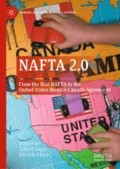Abstract
After US President Trump announced the intention of his administration to either renegotiate or break the North American Free Trade Agreement (NAFTA), the renegotiation began in mid-August 2017 and concluded in late September 2018. NAFTA 2.0, henceforth known as the United States–Mexico–Canada Agreement (USMCA), was signed in November 2018. Following further negotiations, a Protocol of Amendment was concluded in December 2019. After being approved in its three states parties, the USMCA entered into force on July 1, 2020. The renegotiation of the NAFTA sparked a lot of interest. The introduction returns to the essentials of the NAFTA, considers its renegotiation, summarizes the main elements of the USMCA, while contrasting it with the NAFTA, and presents the various chapters of the book.
Access this chapter
Tax calculation will be finalised at checkout
Purchases are for personal use only
Notes
- 1.
- 2.
The TPP grouped 12 countries of the Pacific rim: Australia, Brunei, Canada, Chile, Japan, Malaysia, Mexico, New Zealand, Peru, Singapore, the United States, Vietnam.
- 3.
Claims from existing investments remain eligible for arbitration under NAFTA provisions for three years from the termination of the agreement.
- 4.
The CETA groups Canada and the European Union.
References
Anderson, Greg. 2020. Freeing Trade in North America. Montreal and Kingston: McGill-Queen’s University Press.
Brunelle, Dorval. ed. 2014. L’ALENA à 20 ans: un accord en sursis, un modèle en essor. Montreal: Éditions IEIM.
Brunelle, Dorval, and Christian Deblock. eds. 2004. L’ALENA: le libre-échange en défaut. Montreal: Fides.
Cameron, Maxwell A., and Brian W. Tomlin. 2000. The Making of NAFTA: How the Deal Was Done. Ithaca, NY: Cornell University Press.
Comprehensive and Progressive Agreement for Trans-Pacific Partnership (CPTPP), signed March 8, 2018, entered into force December 30, 2018. https://www.mfat.govt.nz/en/trade/free-trade-agreements/free-trade-agreements-in-force/cptpp/comprehensive-and-progressive-agreement-for-trans-pacific-partnership-text-and-resources/.
Gantz, David A. 2020. An Introduction to the United States-Mexico-Canada Agreement: Understanding the New NAFTA. Cheltenham, UK/Northampton, MA: Edward Elgar.
Government Procurement Agreement (GPA), as amended March 30, 2012. https://www.wto.org/english/docs_e/legal_e/rev-gpr-94_01_e.pdf.
Hufbauer, Gary Clyde, Cathleen Cimino, and Tyler Moran. 2014. NAFTA at 20: Misleading Charges and Positive Achievements. Peterson Institute for International Economics, Number PB14–13, May. https://www.piie.com/sites/default/files/publications/pb/pb14-13.pdf.
Lester, Simon, and Inu Manak. 2018. The Rise of Populist Nationalism and the Renegotiation of NAFTA. Journal of International Economic Law 21 (1): 151–169.
North American Free Trade Agreement (NAFTA), signed December 17, 1992, entered into force January 1, 1994. https://www.nafta-sec-alena.org/Home/Legal-Texts/North-American-Free-Trade-Agreement.
Office of the United States Trade Representative (USTR). 2017. Summary of Objectives for the NAFTA Renegotiation, November. https://ustr.gov/sites/default/files/files/Press/Releases/Nov%20Objectives%20Update.pdf.
Protocol of Amendment to the Agreement between the United States of America, the United Mexican States, and Canada, signed December 10, 2019. https://ustr.gov/sites/default/files/files/agreements/FTA/USMCA/Protocol-of-Amendments-to-the-United-States-Mexico-Canada-Agreement.pdf.
Scott, Robert E., Carlos Salas, and Bruce Campbell. 2006. Revisiting NAFTA: Still Not Working for North America’s Workers. Economic Policy Institute, Briefing Paper #173, September 28. https://files.epi.org/page/-/old/briefingpapers/173/bp173.pdf.
Siripurapu, Anshu. 2018. Trudeau: Chapter 19, cultural exemptions are NAFTA red lines for Canada. World Trade Online, September 4.
Stargardter, Gabriel. 2017. Mexico sets out NAFTA goals ahead of re-negotiation talks: document. Reuters, August 1. https://www.reuters.com/article/us-usa-trade-mexico/mexico-sets-out-nafta-goals-ahead-of-re-negotiation-talks-document-idUSKBN1AH4VW.
Trans-Pacific Partnership (TPP), signed February 4, 2016. https://www.international.gc.ca/trade-commerce/trade-agreements-accords-commerciaux/agr-acc/tpp-ptp/text-texte/toc-tdm.aspx?lang=eng.
United States—Canada Free Trade Agreement (USCFTA), signed January 2, 1988, entered into force January 1, 1989. http://www.international.gc.ca/trade-agreements-accords-commerciaux/assets/pdfs/cusfta-e.pdf.
United States-Mexico-Canada Agreement (USMCA), signed November 30, 2018, entered into force July 1, 2020. https://ustr.gov/trade-agreements/free-trade-agreements/united-states-mexico-canada-agreement/agreement-between.
Villarreal, M. Angeles, and Ian F. Fergusson. 2020. The United States-Mexico-Canada Agreement (USMCA). Congressional Research Service, Report R44981, July 27. https://crsreports.congress.gov/product/pdf/R/R44981/19.
White House. 2021. Ensuring Future of America is Made in America by All of America’s Workers: Executive Order, Fact sheet, January 25. https://insidetrade.com/sites/insidetrade.com/files/documents/2021/jan/wto2021_0051a.pdf.
Author information
Authors and Affiliations
Corresponding author
Editor information
Editors and Affiliations
Rights and permissions
Copyright information
© 2022 The Author(s), under exclusive license to Springer Nature Switzerland AG
About this chapter
Cite this chapter
Gagné, G., Rioux, M. (2022). Introduction. In: Gagné, G., Rioux, M. (eds) NAFTA 2.0. Canada and International Affairs. Palgrave Macmillan, Cham. https://doi.org/10.1007/978-3-030-81694-0_1
Download citation
DOI: https://doi.org/10.1007/978-3-030-81694-0_1
Published:
Publisher Name: Palgrave Macmillan, Cham
Print ISBN: 978-3-030-81693-3
Online ISBN: 978-3-030-81694-0
eBook Packages: Political Science and International StudiesPolitical Science and International Studies (R0)

